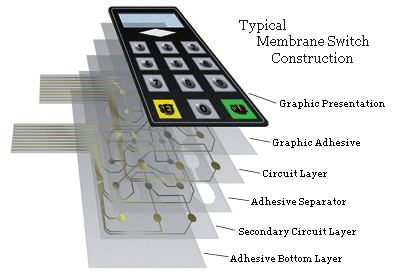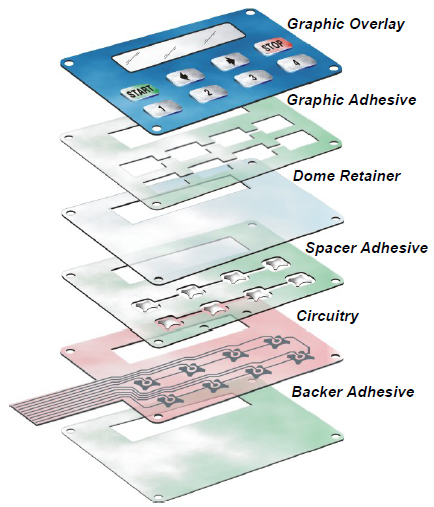Everything About Membrane Change: Understanding Its Layout and Capability
When you think about the control interfaces in modern tools, membrane layer switches typically come to mind. These components are greater than just buttons; they blend design and functionality perfectly. Understanding exactly how they work and what makes them effective can transform your perspective on day-to-day electronics. But, there are nuances to their design and efficiency that you could not recognize. Let's discover what sets membrane switches aside from other control systems.
What Are Membrane Layer Buttons?

Membrane layer buttons can additionally be tailored pertaining to form, size, and graphics, enabling makers to create unique interfaces tailored to particular items. Generally, membrane buttons play a considerable function in improving customer experience throughout a large variety of applications.
How Membrane Layer Switches Work
When you press a secret on a membrane layer button, it activates a straightforward yet reliable system. The leading layer, frequently made of versatile product, lowers onto a conductive layer under it. This action bridges the space in between conductive traces, finishing an electric circuit. As quickly as the circuit shuts, it sends out a signal to the tool's controller, which interprets your input.
You'll see that the tactile responses varies based on the switch design, supplying either a soft click or a much more noticable response. As soon as you launch the trick, the membrane go back to its initial setting, resuming the circuit and quiting the signal. This process occurs nearly instantaneously, making certain a receptive individual experience.
Membrane switches are prominent due to their resilience and resistance to dust and dampness, making them suitable for numerous applications, from house devices to clinical gadgets. Recognizing this procedure helps you value their prevalent usage.
Key Parts of Membrane Buttons
Comprehending the crucial components of membrane layer switches is essential for comprehending their functionality and style. The protective layer guards versus environmental elements and put on, expanding the button's lifespan. By recognizing these parts, you'll obtain insight right into just how membrane changes operate and their value in numerous applications.
Products Made Use Of in Membrane Switch Design
The efficiency and resilience of membrane layer switches heavily rely on the materials made use of in their design. You generally run into polyester and polycarbonate as main substratums because of their outstanding toughness and adaptability. These products withstand scratches and chemicals, making them perfect for requiring settings.
The conductive layers typically make use of silver or carbon, chosen for their reliability and conductivity. membrane switch manufacturer. Silver offers exceptional efficiency, while carbon is an economical option. For the overlay, you might take into consideration a matte or glossy finish, depending upon your visual demands and user experience
Adhesives play an important function too; they bond layers securely and guarantee longevity. Ensure to choose adhesives that hold up against ecological factors like temperature level and humidity. Ultimately, do not forget the relevance of a good printing method for graphics, as it boosts both capability and aesthetic charm. Choosing the right materials will guarantee your membrane layer button stands the examination of time.
Design Considerations for Membrane Switches
While making membrane layer buttons, it's crucial to think about different elements that influence their functionality and individual experience. Beginning by concentrating on the design and button dimension; make sure they're instinctive and very easy to navigate. Consider the responsive responses you intend to give-- will individuals need a visible click or a softer touch? In addition, think regarding the materials you'll utilize, as they'll affect durability and looks.
Do not neglect the graphic design; clear labeling and shade comparison are significant for presence. Verify your design accommodates environmental variables, like wetness or temperature variants, which might affect performance. Remember the value of testing models with actual individuals to collect responses and make necessary adjustments. This repetitive process assists you refine the style, verifying it satisfies both functional and visual needs effectively. By meticulously considering these components, you'll produce a membrane layer switch that boosts usability and complete satisfaction.
Applications of Membrane Buttons
Membrane layer switches are versatile parts found in various applications, from industrial equipment to customer electronic devices. You'll see their impact in devices that require durable interfaces and in tools that gain from sleek styles. Comprehending these applications helps you appreciate the functionality and usefulness of membrane layer buttons in day-to-day modern technology.
Industrial Tools Usage
When you're seeking to enhance the performance of commercial devices, membrane layer buttons use a trustworthy option that combines sturdiness with user-friendly style. These switches are ideal for rough settings, supplying resistance to dirt, dampness, and chemicals. You'll locate them in control panels for making machines, heating and cooling systems, and medical gadgets, where accuracy and responsiveness are crucial. Their low profile implies they fit perfectly right into different devices, conserving beneficial space while maintaining simplicity of use. With adjustable graphics and backlighting options, you can produce an user-friendly interface for operators, boosting effectiveness and safety and security. Plus, their long life expectancy minimizes upkeep expenses, making them a clever financial investment for your commercial applications. Welcome membrane layer buttons to simplify your operations and improve general efficiency.
Customer Electronics Integration
In the domain name of consumer click this link electronics, membrane layer buttons play an essential role in boosting customer interaction and gadget functionality. You'll discover them in gadgets like microwaves, remotes, and video gaming consoles, giving a smooth method to communicate with modern technology. Their smooth design permits easy assimilation into numerous items, making controls intuitive and straightforward. With their ability to integrate graphics and backlighting, you can delight in a modern-day visual that matches the tool's overall look. Membrane layer switches additionally ensure durability and resistance to dust and dampness, expanding the lifespan of your electronic devices. By picking membrane buttons, you boost not simply the capability yet additionally the design of your tools, making day-to-day communications smooth and pleasurable.
Benefits and Downsides of Membrane Layer Buttons
While membrane layer buttons provide a series of benefits, they likewise come with some drawbacks that you should consider. One considerable benefit is their portable layout, making them perfect for space-constrained applications. They're likewise cost-effective, supplying a long lasting solution with a low manufacturing price. Additionally, their smooth surface area is very easy to clean, boosting hygiene in settings like healthcare facilities.

Membrane switches can have a shorter life-span contrasted to mechanical switches, specifically under heavy usage. They can also be much less tactile, which could influence customer feedback during procedure. Stabilizing these pros and cons will aid you establish if membrane buttons are the best fit for your task.
Frequently Asked Questions
For How Long Do Membrane Layer Switches Over Commonly Last?
Membrane switches usually last in between 5 to 10 years, relying on usage and ecological problems. You'll desire to assess elements like wear, exposure to wetness, and temperature variations to determine their longevity properly.
Can Membrane Switches Over Be Personalized for Details Layouts?
Yes, you can customize membrane switches to fit certain layouts (membrane switch manufacturer). You'll have the freedom to pick colors, forms, and layouts that match your job's needs, guaranteeing they mix flawlessly with your important site total aesthetic
What Is the Expense Range for Membrane Switch Over Production?
The price variety for membrane layer switch production commonly drops between $1 and $10 each, depending on elements like style complexity, amount, and materials. You can get quotes from producers to discover the finest choice.

Are Membrane Switches Over Water Resistant or Resistant?
Membrane layer buttons can be made to be waterproof or immune, depending upon products used and building methods. If you require go to this website them for damp settings, assure you define those demands during the layout process.
How Do Membrane Layer Switches Over Compare to Conventional Buttons?
Membrane layer switches are generally thinner and more flexible than conventional switches, using a streamlined design. They're often less complicated to clean and incorporate, yet could not supply the responsive feedback you're used to with mechanical alternatives.
Verdict
